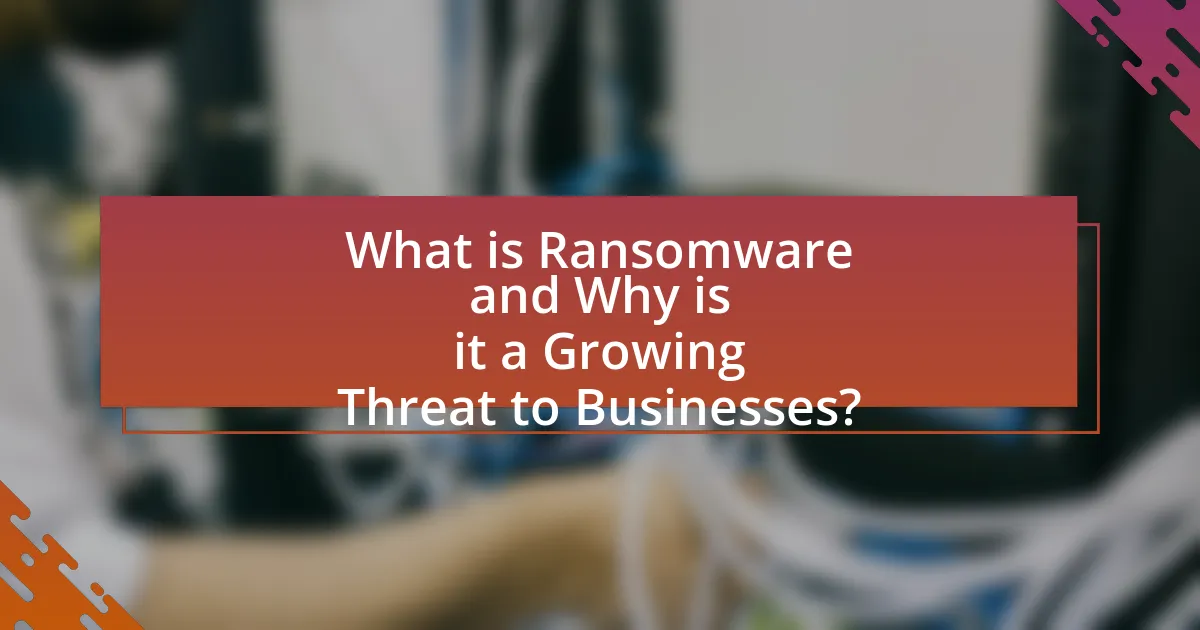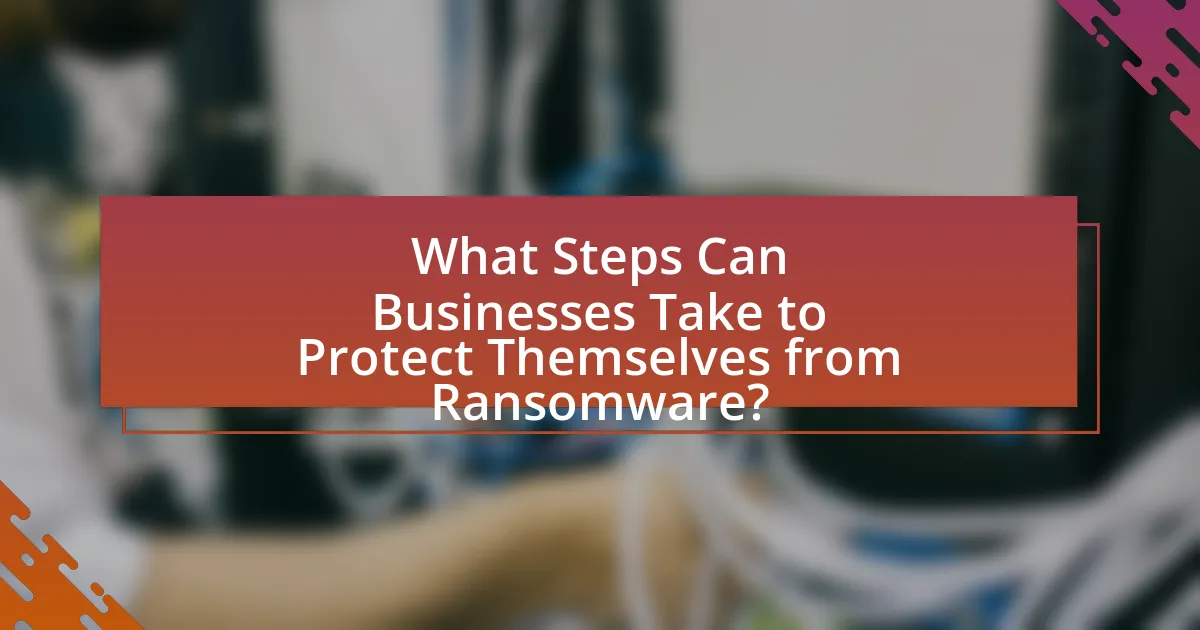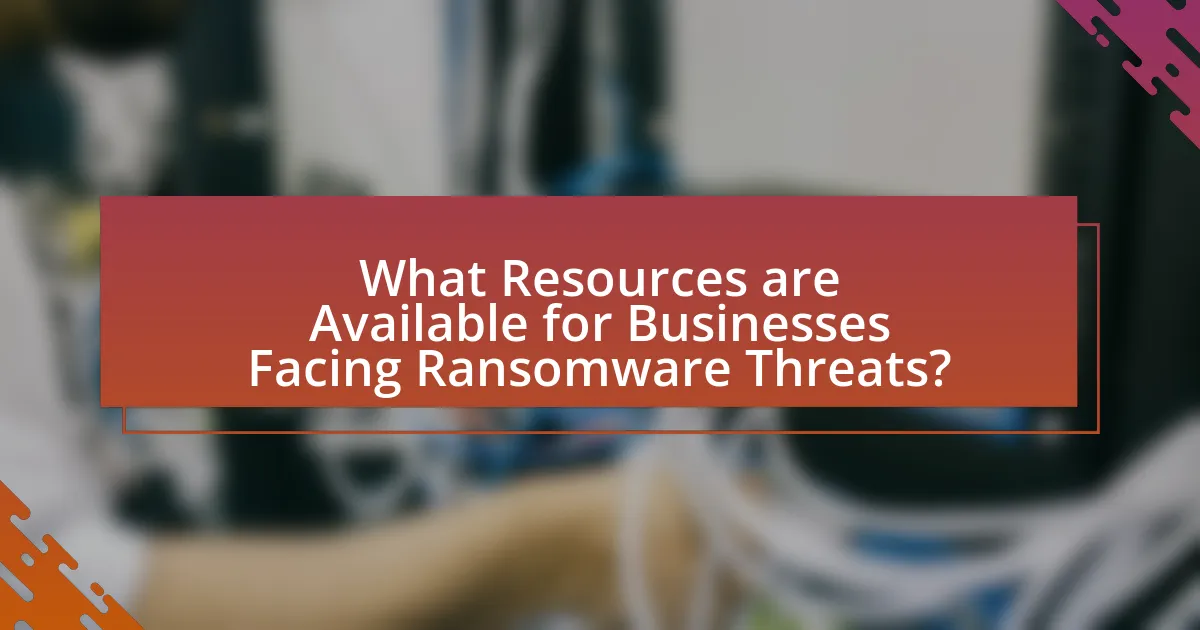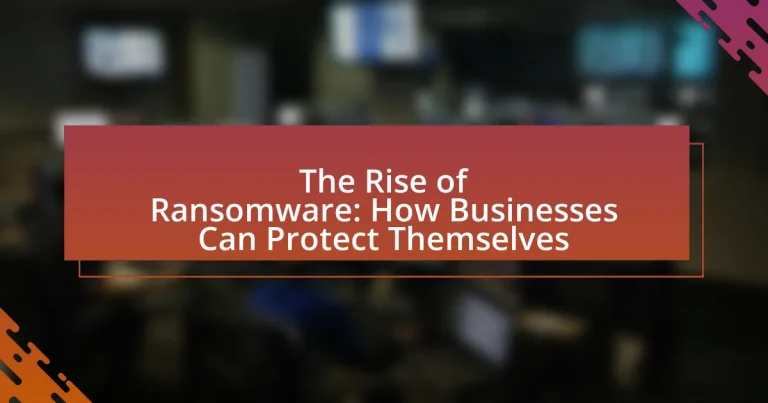Ransomware is a malicious software that encrypts files on a victim’s system, demanding a ransom for decryption. The increasing sophistication and frequency of ransomware attacks pose a significant threat to businesses, particularly due to the rise of remote work and inadequate cybersecurity measures. This article explores how ransomware operates, the various types of ransomware, and the common methods of infection. It also highlights the vulnerabilities businesses face, the importance of employee training, and effective strategies for prevention and response. Key recommendations include implementing robust cybersecurity measures, regular data backups, and developing comprehensive incident response plans to mitigate the impact of ransomware attacks.

What is Ransomware and Why is it a Growing Threat to Businesses?
Ransomware is a type of malicious software that encrypts a victim’s files, rendering them inaccessible until a ransom is paid to the attacker. This threat is growing for businesses due to the increasing sophistication of ransomware attacks, which have escalated in frequency and severity; for instance, the FBI reported that ransomware incidents increased by 300% in 2020 alone. Additionally, the rise of remote work has expanded the attack surface, making it easier for cybercriminals to exploit vulnerabilities in corporate networks. The financial impact of ransomware can be devastating, with businesses facing not only the cost of the ransom but also potential downtime, data loss, and reputational damage.
How does ransomware operate and infect systems?
Ransomware operates by encrypting files on a victim’s system and demanding a ransom for the decryption key. It typically infects systems through phishing emails, malicious attachments, or exploit kits that take advantage of software vulnerabilities. Once executed, the ransomware encrypts files and displays a ransom note, often threatening data loss or public exposure if the ransom is not paid. According to the Cybersecurity & Infrastructure Security Agency (CISA), ransomware attacks have increased significantly, with a reported 62% rise in incidents from 2019 to 2020, highlighting the urgency for businesses to implement robust cybersecurity measures.
What are the common methods used by ransomware to spread?
Ransomware commonly spreads through phishing emails, exploit kits, and remote desktop protocol (RDP) attacks. Phishing emails often contain malicious attachments or links that, when clicked, download the ransomware onto the victim’s system. According to the Cybersecurity and Infrastructure Security Agency (CISA), over 90% of successful cyberattacks begin with a phishing email. Exploit kits take advantage of vulnerabilities in software to install ransomware without user interaction. Additionally, RDP attacks involve unauthorized access to systems through weak passwords or unpatched vulnerabilities, allowing attackers to deploy ransomware directly. These methods highlight the importance of robust cybersecurity measures to prevent ransomware infections.
How do ransomware attacks typically unfold?
Ransomware attacks typically unfold in a series of stages: initial infiltration, encryption of files, and ransom demand. First, attackers gain access to a system through methods such as phishing emails, exploiting vulnerabilities, or using remote desktop protocol (RDP) attacks. Once inside, they deploy malware that encrypts critical files, rendering them inaccessible to the victim. Following the encryption, the attackers present a ransom note, demanding payment in cryptocurrency for the decryption key. According to the Cybersecurity & Infrastructure Security Agency (CISA), in 2021, 37% of organizations reported being victims of ransomware, highlighting the prevalence and impact of these attacks.
What types of ransomware exist?
There are several types of ransomware, including encrypting ransomware, locker ransomware, and scareware. Encrypting ransomware, such as WannaCry and CryptoLocker, encrypts files on the victim’s system, making them inaccessible until a ransom is paid. Locker ransomware, like the infamous Reveton, locks users out of their devices entirely, demanding payment to regain access. Scareware, on the other hand, displays alarming messages to trick users into paying for fake security software. These classifications highlight the various methods ransomware employs to extort money from victims, demonstrating the evolving nature of cyber threats.
What distinguishes crypto-ransomware from locker ransomware?
Crypto-ransomware encrypts files on a victim’s system, rendering them inaccessible until a ransom is paid, while locker ransomware locks the user out of their device or system without necessarily encrypting files. The primary distinction lies in the method of attack: crypto-ransomware focuses on file encryption, making recovery without the decryption key nearly impossible, whereas locker ransomware restricts access to the system itself, often displaying a ransom note on the screen. This difference in approach affects the recovery options available to victims, with crypto-ransomware typically resulting in more severe data loss if backups are not available.
How do ransomware-as-a-service models impact the threat landscape?
Ransomware-as-a-service (RaaS) models significantly increase the threat landscape by lowering the entry barriers for cybercriminals, enabling even those with limited technical skills to launch sophisticated attacks. This model allows attackers to rent ransomware tools and infrastructure, leading to a surge in ransomware incidents; for instance, the FBI reported a 300% increase in ransomware attacks in 2020 compared to the previous year. Additionally, RaaS fosters a more organized cybercrime ecosystem, where affiliates share tactics and resources, further complicating detection and response efforts for businesses.
Why are businesses particularly vulnerable to ransomware attacks?
Businesses are particularly vulnerable to ransomware attacks due to their reliance on digital infrastructure and the often inadequate cybersecurity measures in place. Many organizations store sensitive data and critical operations online, making them attractive targets for cybercriminals. According to a report by Cybersecurity Ventures, ransomware attacks are expected to cost businesses over $20 billion globally by 2021, highlighting the financial impact of these threats. Additionally, a lack of employee training on cybersecurity best practices increases the risk of successful phishing attempts, which are commonly used to deploy ransomware. This combination of valuable data, insufficient security protocols, and human error creates an environment where businesses are at heightened risk for ransomware attacks.
What role does employee training play in vulnerability?
Employee training plays a critical role in reducing vulnerability to ransomware attacks. By equipping employees with knowledge about cybersecurity best practices, organizations can significantly lower the risk of human error, which is a leading cause of security breaches. Research indicates that 95% of cybersecurity incidents are due to human mistakes, highlighting the importance of effective training programs. Regular training sessions that cover topics such as phishing detection, password management, and safe internet practices empower employees to recognize and respond appropriately to potential threats, thereby enhancing the overall security posture of the organization.
How does outdated technology contribute to the risk of ransomware?
Outdated technology significantly increases the risk of ransomware attacks due to its lack of security updates and vulnerabilities. Systems that are not regularly updated often contain known security flaws that cybercriminals exploit to gain unauthorized access. For instance, a report by Cybersecurity & Infrastructure Security Agency (CISA) highlighted that outdated software is a common entry point for ransomware, as attackers can leverage unpatched vulnerabilities to infiltrate networks. Additionally, older hardware may not support modern security protocols, further exposing organizations to threats. Therefore, the reliance on outdated technology creates an environment ripe for ransomware exploitation.

What Steps Can Businesses Take to Protect Themselves from Ransomware?
Businesses can protect themselves from ransomware by implementing a multi-layered security strategy that includes regular data backups, employee training, and robust cybersecurity measures. Regularly backing up data ensures that businesses can restore their systems without paying a ransom, as 60% of small businesses that experience a ransomware attack go out of business within six months, according to a report by the National Cyber Security Alliance. Employee training on recognizing phishing attempts and suspicious links is crucial, as human error is a significant factor in ransomware attacks. Additionally, deploying firewalls, antivirus software, and intrusion detection systems can help prevent unauthorized access to sensitive data. Regular software updates and patch management are also essential, as vulnerabilities in outdated software can be exploited by attackers.
How can businesses implement effective cybersecurity measures?
Businesses can implement effective cybersecurity measures by adopting a multi-layered security approach that includes employee training, regular software updates, and robust data encryption. Employee training is crucial, as human error is a leading cause of security breaches; according to a report by IBM, 95% of cybersecurity incidents are due to human mistakes. Regular software updates ensure that systems are protected against known vulnerabilities, as outdated software can be an easy target for attackers. Additionally, data encryption protects sensitive information, making it unreadable to unauthorized users, which is essential in the event of a data breach. Implementing these measures can significantly reduce the risk of ransomware attacks and enhance overall cybersecurity resilience.
What are the best practices for data backup and recovery?
The best practices for data backup and recovery include implementing a 3-2-1 backup strategy, which involves keeping three copies of data on two different media types, with one copy stored offsite. This approach minimizes the risk of data loss due to ransomware attacks, hardware failures, or natural disasters. Regularly testing backups ensures that data can be restored effectively when needed, and using encryption protects sensitive information during storage and transmission. Additionally, automating backup processes reduces human error and ensures consistency. According to a study by the Ponemon Institute, organizations that follow structured backup and recovery practices experience significantly less downtime and data loss, reinforcing the importance of these best practices.
How can businesses enhance their network security?
Businesses can enhance their network security by implementing a multi-layered security approach that includes firewalls, intrusion detection systems, and regular software updates. This strategy effectively reduces vulnerabilities by creating barriers against unauthorized access and ensuring that all systems are protected against known threats. According to a report by Cybersecurity Ventures, global spending on cybersecurity is expected to exceed $1 trillion from 2017 to 2021, highlighting the increasing recognition of the need for robust security measures. Additionally, the National Institute of Standards and Technology (NIST) recommends regular risk assessments and employee training to further strengthen security protocols, ensuring that all personnel are aware of potential threats and best practices for mitigating them.
What role does employee education play in ransomware prevention?
Employee education plays a critical role in ransomware prevention by equipping staff with the knowledge to recognize and respond to potential threats. Training programs that focus on identifying phishing attempts, understanding safe browsing practices, and recognizing suspicious email attachments significantly reduce the likelihood of successful ransomware attacks. According to a study by the Ponemon Institute, organizations that invest in employee training can reduce the risk of a data breach by up to 70%. This highlights the importance of continuous education in fostering a security-aware culture, ultimately leading to enhanced organizational resilience against ransomware threats.
How can businesses train employees to recognize phishing attempts?
Businesses can train employees to recognize phishing attempts by implementing comprehensive training programs that include simulated phishing exercises, educational workshops, and regular updates on the latest phishing tactics. Simulated phishing exercises allow employees to experience real-world scenarios in a controlled environment, enhancing their ability to identify suspicious emails and links. Educational workshops can cover key indicators of phishing, such as poor grammar, urgent language, and unfamiliar sender addresses. Regular updates on evolving phishing tactics ensure that employees remain vigilant and informed. According to a study by the Ponemon Institute, organizations that conduct regular security awareness training can reduce the likelihood of falling victim to phishing attacks by up to 70%.
What ongoing training programs should be established?
Ongoing training programs that should be established include cybersecurity awareness training, incident response drills, and phishing simulation exercises. Cybersecurity awareness training educates employees about the latest ransomware threats and safe online practices, which is crucial as human error is a significant factor in ransomware attacks. Incident response drills prepare teams to react swiftly and effectively to a ransomware incident, reducing potential damage. Phishing simulation exercises test employees’ ability to recognize phishing attempts, which are often the entry point for ransomware. According to a report by the Cybersecurity and Infrastructure Security Agency, organizations that implement regular training see a 70% reduction in successful phishing attacks, highlighting the effectiveness of these programs.
How can businesses respond to a ransomware attack if it occurs?
Businesses can respond to a ransomware attack by immediately isolating affected systems to prevent further spread of the malware. This action is crucial as it limits the attack’s impact and protects unaffected systems. Following isolation, businesses should assess the extent of the damage, which includes identifying encrypted files and determining if backups are available. According to a report by Cybersecurity Ventures, 60% of small companies that experience a ransomware attack go out of business within six months, highlighting the urgency of a swift response.
Next, businesses should notify law enforcement and cybersecurity professionals to assist in the recovery process. Engaging with experts can provide insights into decryption options and recovery strategies. Additionally, organizations must communicate transparently with stakeholders about the incident to maintain trust and manage reputational risks.
Finally, businesses should review and strengthen their cybersecurity measures to prevent future attacks, including employee training, regular backups, and updated security protocols. The FBI recommends maintaining offline backups and implementing multi-factor authentication as effective preventive measures against ransomware attacks.
What immediate actions should be taken following an attack?
Immediately following a ransomware attack, businesses should isolate affected systems to prevent further spread of the malware. This action is critical as it limits the attack’s impact and protects unaffected systems. Additionally, organizations must notify their IT security team and relevant stakeholders to initiate an incident response plan. According to the Cybersecurity and Infrastructure Security Agency (CISA), prompt reporting and response can significantly mitigate damage and recovery time. Furthermore, businesses should begin data recovery processes from backups, ensuring that these backups are clean and unaffected by the ransomware. This approach is supported by the fact that timely recovery efforts can reduce downtime and financial losses associated with ransomware incidents.
How can businesses communicate with stakeholders during a crisis?
Businesses can communicate with stakeholders during a crisis by establishing clear, timely, and transparent communication channels. Effective communication involves using multiple platforms such as emails, press releases, social media, and dedicated crisis management websites to ensure stakeholders receive consistent updates. For instance, during a ransomware attack, companies like Maersk utilized real-time updates through their website and social media to inform customers and partners about the situation and recovery efforts. This approach not only keeps stakeholders informed but also helps maintain trust and credibility during challenging times.

What Resources are Available for Businesses Facing Ransomware Threats?
Businesses facing ransomware threats can access a variety of resources, including cybersecurity frameworks, incident response plans, and educational materials. The National Institute of Standards and Technology (NIST) provides a Cybersecurity Framework that helps organizations manage and reduce cybersecurity risk. Additionally, the Cybersecurity and Infrastructure Security Agency (CISA) offers resources such as the Ransomware Guide, which outlines best practices for prevention and response. Furthermore, businesses can utilize cybersecurity insurance to mitigate financial losses associated with ransomware attacks. According to a report by Cybersecurity Ventures, global ransomware damages are projected to reach $265 billion by 2031, emphasizing the importance of these resources in protecting against such threats.
What tools and software can help mitigate ransomware risks?
To mitigate ransomware risks, businesses can utilize tools and software such as endpoint protection platforms, backup solutions, and network security appliances. Endpoint protection platforms like CrowdStrike and SentinelOne provide real-time threat detection and response capabilities, significantly reducing the likelihood of ransomware infections. Backup solutions, such as Veeam and Acronis, enable regular data backups, ensuring that businesses can restore their systems without paying ransoms. Additionally, network security appliances, including firewalls from Fortinet and Cisco, help monitor and control incoming and outgoing network traffic, preventing unauthorized access that could lead to ransomware attacks. These tools collectively enhance a business’s cybersecurity posture, making it more resilient against ransomware threats.
How can antivirus and anti-malware solutions protect against ransomware?
Antivirus and anti-malware solutions protect against ransomware by detecting, blocking, and removing malicious software before it can encrypt files. These solutions utilize signature-based detection to identify known ransomware variants and heuristic analysis to recognize suspicious behavior indicative of ransomware attacks. For instance, according to a report by Cybersecurity Ventures, ransomware damages are projected to reach $265 billion by 2031, highlighting the critical need for effective protection. Additionally, many antivirus programs offer real-time scanning and behavior monitoring, which can prevent ransomware from executing and spreading within a network.
What role do firewalls play in ransomware defense?
Firewalls play a critical role in ransomware defense by monitoring and controlling incoming and outgoing network traffic based on predetermined security rules. They act as a barrier between trusted internal networks and untrusted external networks, effectively blocking unauthorized access and potential ransomware attacks. According to a report by Cybersecurity Ventures, organizations that implement firewalls can reduce the risk of ransomware infections by up to 50%, as firewalls can detect and prevent malicious traffic before it reaches vulnerable systems. This proactive defense mechanism is essential for safeguarding sensitive data and maintaining business continuity in the face of increasing ransomware threats.
What are the best practices for incident response planning?
The best practices for incident response planning include establishing a clear incident response team, defining roles and responsibilities, and developing a comprehensive incident response plan. An effective incident response team should consist of members from various departments, including IT, legal, and communications, to ensure a coordinated response. Clearly defined roles and responsibilities help streamline the response process and minimize confusion during an incident. A comprehensive incident response plan should outline procedures for identifying, containing, eradicating, and recovering from incidents, as well as communication strategies for stakeholders. According to the National Institute of Standards and Technology (NIST) Special Publication 800-61, organizations that implement structured incident response plans can reduce the impact of security incidents by up to 50%.
How can businesses develop a comprehensive incident response plan?
Businesses can develop a comprehensive incident response plan by following a structured approach that includes preparation, detection, analysis, containment, eradication, recovery, and post-incident review. This framework ensures that organizations are equipped to respond effectively to incidents, particularly in the context of rising ransomware threats.
Preparation involves establishing an incident response team, defining roles and responsibilities, and providing training. Detection and analysis require implementing monitoring tools to identify potential incidents and assessing their impact. Containment strategies must be developed to limit damage, while eradication focuses on removing the threat from the environment. Recovery processes should be in place to restore systems and data, and a post-incident review is essential for learning and improving future responses.
According to the Ponemon Institute’s “2021 Cost of a Data Breach Report,” organizations with an incident response plan can reduce the cost of a data breach by an average of $2 million, highlighting the importance of having a well-defined strategy in place.
What should be included in a ransomware response checklist?
A ransomware response checklist should include immediate isolation of affected systems, assessment of the extent of the attack, communication with stakeholders, and engagement with cybersecurity professionals. Isolating affected systems prevents further spread of the ransomware, while assessing the attack helps determine the data impacted and the potential for recovery. Communication with stakeholders, including employees and customers, is crucial for transparency and trust. Engaging cybersecurity professionals ensures that the response is handled effectively, leveraging their expertise to mitigate damage and restore systems. These steps are essential as they align with best practices recommended by cybersecurity frameworks, such as the NIST Cybersecurity Framework, which emphasizes incident response planning and execution.
What practical tips can businesses implement to enhance their ransomware defenses?
Businesses can enhance their ransomware defenses by implementing a multi-layered security approach that includes regular data backups, employee training, and robust security software. Regularly backing up data ensures that businesses can restore their systems without paying a ransom, as 60% of companies that experience a ransomware attack go out of business within six months if they do not have a backup plan. Employee training is crucial, as human error is a leading cause of ransomware infections; organizations that conduct regular cybersecurity training can reduce the risk of such incidents significantly. Additionally, deploying advanced security software, including firewalls and intrusion detection systems, can help detect and block ransomware before it infiltrates the network. According to a report by Cybersecurity Ventures, global ransomware damage costs are expected to reach $265 billion by 2031, underscoring the importance of these defensive measures.




